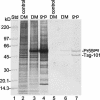Passive and active inclusion of host proteins in human immunodeficiency virus type 1 gag particles during budding at the plasma membrane
- PMID: 15140966
- PMCID: PMC415843
- DOI: 10.1128/JVI.78.11.5686-5697.2004
Passive and active inclusion of host proteins in human immunodeficiency virus type 1 gag particles during budding at the plasma membrane
Abstract
Human immunodeficiency virus type 1 particles form by budding at the surface of most cell types. In this process, a piece of the plasma membrane is modified into an enveloped virus particle. The process is driven by the internal viral protein Pr55(gag). We have studied how host proteins in the membrane are dealt with by Pr55(gag) during budding. Are they included in or excluded from the particle? The question was approached by measuring the relative concentrations of host and viral proteins in the envelope of Pr55(gag) particles and in their donor membranes in the cell. We observed that the bulk of the host proteins, including actin and clathrin, were passively included into the virus-like Gag particles. This result suggests that budding by Pr55(gag) proceeds without significant alteration of the original host protein composition at the cell membrane. Nevertheless, some proteins were concentrated in the particles, and a few were excluded. The concentrated proteins included cyclophilin A and Tsg-101. These were recruited to the plasma membrane by Pr55(gag). The membrane-bound cyclophilin A was concentrated into particles as efficiently as Pr55(gag), whereas Tsg-101 was concentrated more efficiently. The latter finding is consistent with a role for Tsg-101 in Gag particle release.
Figures









Similar articles
-
Human immunodeficiency virus type 1 assembly and lipid rafts: Pr55(gag) associates with membrane domains that are largely resistant to Brij98 but sensitive to Triton X-100.J Virol. 2003 Apr;77(8):4805-17. doi: 10.1128/jvi.77.8.4805-4817.2003. J Virol. 2003. PMID: 12663787 Free PMC article.
-
Tsg101, a homologue of ubiquitin-conjugating (E2) enzymes, binds the L domain in HIV type 1 Pr55(Gag).Proc Natl Acad Sci U S A. 2001 Jul 3;98(14):7724-9. doi: 10.1073/pnas.131059198. Epub 2001 Jun 26. Proc Natl Acad Sci U S A. 2001. PMID: 11427703 Free PMC article.
-
Nedd4.1-mediated ubiquitination and subsequent recruitment of Tsg101 ensure HTLV-1 Gag trafficking towards the multivesicular body pathway prior to virus budding.J Cell Sci. 2004 May 1;117(Pt 11):2357-67. doi: 10.1242/jcs.01095. J Cell Sci. 2004. PMID: 15126635
-
Post-Translational Modifications of Retroviral HIV-1 Gag Precursors: An Overview of Their Biological Role.Int J Mol Sci. 2021 Mar 11;22(6):2871. doi: 10.3390/ijms22062871. Int J Mol Sci. 2021. PMID: 33799890 Free PMC article. Review.
-
Essential and supporting host cell factors for HIV-1 budding.Future Microbiol. 2011 Oct;6(10):1159-70. doi: 10.2217/fmb.11.100. Future Microbiol. 2011. PMID: 22004035 Review.
Cited by
-
Mechanisms for Env glycoprotein acquisition by retroviruses.AIDS Res Hum Retroviruses. 2011 Mar;27(3):239-47. doi: 10.1089/AID.2010.0350. Epub 2011 Feb 22. AIDS Res Hum Retroviruses. 2011. PMID: 21247353 Free PMC article. Review.
-
Biochemical and proteomic characterization of retrovirus Gag based microparticles carrying melanoma antigens.Sci Rep. 2016 Jul 11;6:29425. doi: 10.1038/srep29425. Sci Rep. 2016. PMID: 27403717 Free PMC article.
-
Formation and release of arrestin domain-containing protein 1-mediated microvesicles (ARMMs) at plasma membrane by recruitment of TSG101 protein.Proc Natl Acad Sci U S A. 2012 Mar 13;109(11):4146-51. doi: 10.1073/pnas.1200448109. Epub 2012 Feb 6. Proc Natl Acad Sci U S A. 2012. PMID: 22315426 Free PMC article.
-
Packaging of actin into Ebola virus VLPs.Virol J. 2005 Dec 20;2:92. doi: 10.1186/1743-422X-2-92. Virol J. 2005. PMID: 16367999 Free PMC article.
-
Host-encoded reporters for the detection and purification of multiple enveloped viruses.J Virol Methods. 2010 Aug;167(2):178-85. doi: 10.1016/j.jviromet.2010.04.002. Epub 2010 Apr 23. J Virol Methods. 2010. PMID: 20399809 Free PMC article.
References
-
- Arthur, L. O., J. W. Bess, Jr., R. C. Sowder II, R. E. Benveniste, D. L. Mann, J. C. Chermann, and L. E. Henderson. 1992. Cellular proteins bound to immunodeficiency viruses: implications for pathogenesis and vaccines. Science 258:1935-1938. - PubMed
-
- Bess, J. W., Jr., R. J. Gorelick, W. J. Bosche, L. E. Henderson, and L. O. Arthur. 1997. Microvesicles are a source of contaminating cellular proteins found in purified HIV-1 preparations. Virology 230:134-144. - PubMed
Publication types
MeSH terms
Substances
LinkOut - more resources
Full Text Sources
Other Literature Sources
Miscellaneous

